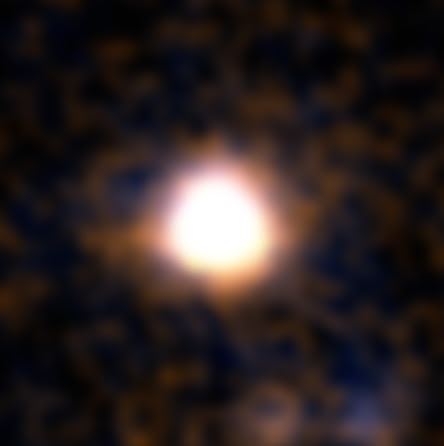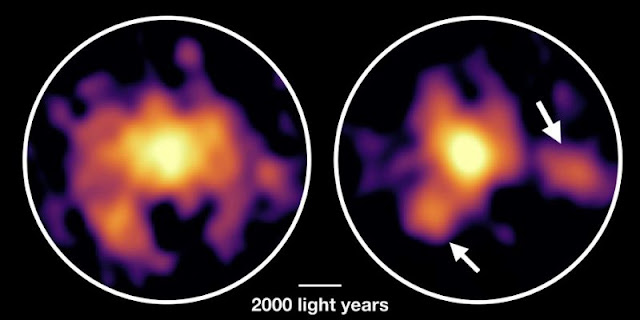So young and already so mature: thanks to observations obtained at the Large Binocular Telescope, an international team of researchers coordinated by Paolo Saracco of the Istituto Nazionale di Astrofisica (INAF, Italy) was able to reconstruct the wild evolutionary history of an extremely massive galaxy that existed 12 billions years ago, when the Universe was only 1,8 billions years old, less than 13% of the present age. This galaxy, dubbed C1-23152, formed in "just" 500 million years, an incredibly short time to give rise to a mass of about 200 billion suns. To do so, it produced as many as 450 stars per year, more than one per day, a star formation rate almost 300 times higher than the current rate in our galaxy, the Milky Way. The information obtained from this study will be fundamental for galaxy formation models for which the nature of objects such as C1-23152 is still difficult to account for.
The most massive galaxies that we observe in the Universe reach masses several hundred billion times that of the Sun and although they are numerically just one third of all galaxies, they contain more than 70% of the stars in the Universe. For this reason, how and how rapidly these galaxies formed are among the most debated questions of modern astrophysics. The current model of galaxy formation - the so-called hierarchical model - predicts that smaller galaxies formed earlier, while more massive systems formed later, through subsequent mergers of the pre-existing smaller galaxies. On the other hand, some of the properties of the most massive galaxies observed in the local Universe, such as the age of their stellar populations, suggest instead that they were formed at early epochs. Unfortunately, the variety of evolutionary phenomena that galaxies can undergo during their lives does not allow us to uniquely define, through studies conducted in the nearby Universe, the way in which they formed, leaving large margins of uncertainty. However, an answer to these questions can come from the study of the properties of massive galaxies in the early Universe, as close as possible to the time when they formed most of their mass.
Seventeen hours of spectroscopic observations with the Large Binocular Telescope (LBT) of the elliptical galaxy C1-23152, previously identified at a distance at which the Universe age was less than 13% of its current age, allowed Saracco’s team to reconstruct its evolutionary history. “The data show that the formation time of C1-23152, that is the time elapsed between the formation of the first stars from the pre-existing gas to the moment when the star formation has almost completely ceased, is less than 500 million of years” says Paolo Saracco, researcher at INAF in Milan and first author of the article published in The Astrophysical Journal. “Also, from the data collected with LBT we were able to establish that in this short time, corresponding to less than 4 hundredths of the age of the Universe, the galaxy formed a mass equal to about 200 billion stars like the Sun, that is about 450 suns per year. Our galaxy, the Milky Way, now forms no more than two a year", adds Danilo Marchesini, full professor at Tufts University and second author of the article. But that is not all. The large amount of information collected allowed the team to quantify for the first time in a galaxy so distant the abundance of chemical elements heavier than helium (the so-called metallicity): the stars of this galaxy have, surprisingly, a higher metallicity than that of the Sun, similar to that observed in the most massive galaxies in the Universe today.
“These observations showed that the formation of the most massive galaxies in the Universe can occur extremely quickly, through an extremely intense star formation process in the early Universe, as for C1-23152", underlines Francesco La Barbera, researcher at INAF in Naples, in the team that conducted the study. "Understanding whether the scenario that describes the formation of C1-23152 is a particular case or whether, on the contrary, it is what happens for most of the most massive galaxies in the Universe is of fundamental importance since this would require a profound revision of the galaxy formation models”, adds Adriana Gargiulo, also a researcher at INAF in Milan and co-author of the study.
The formation of stellar masses as high as for C1-23152 requires both high masses of gas to convert into stars and particular physical conditions. A possible scenario hypothesized by the researchers is that massive primordial gas clouds, falling under the effect of gravitational force in the same region, collide, triggering violent and massive star formation processes. From the observational point of view, the precursors of the most massive galaxies could therefore be remote galaxies with a very high rate of star formation.
"To test our hypotheses, the observations that the next generation of instrumentations will allow us to carry out will be decisive, in particular the James Webb Space Telescope (JWST) which will be launched in orbit at the end of 2021, and the Extremely Large Telescope (ELT) the largest ground-based telescope ever built, with a main mirror of 39 meters in diameter, which will be operational in 2026”, concludes Saracco.
Science Contacts:
- Paolo Saracco, paolo.saracco@inaf.it
- Danilo Marchesini, danilo.marchesini@tufts.edu
- Francesco La Barbera, francesco.labarbera@inaf.it
- Adriana Gargiulo, adriana.gargiulo@inaf.it
INAF Press Release: https://www.media.inaf.it/2020/12/10/galassia-vega/
Publication link: https://arxiv.org/pdf/2011.04657.pdf
Source: Large Binocular Telescope Observatory



